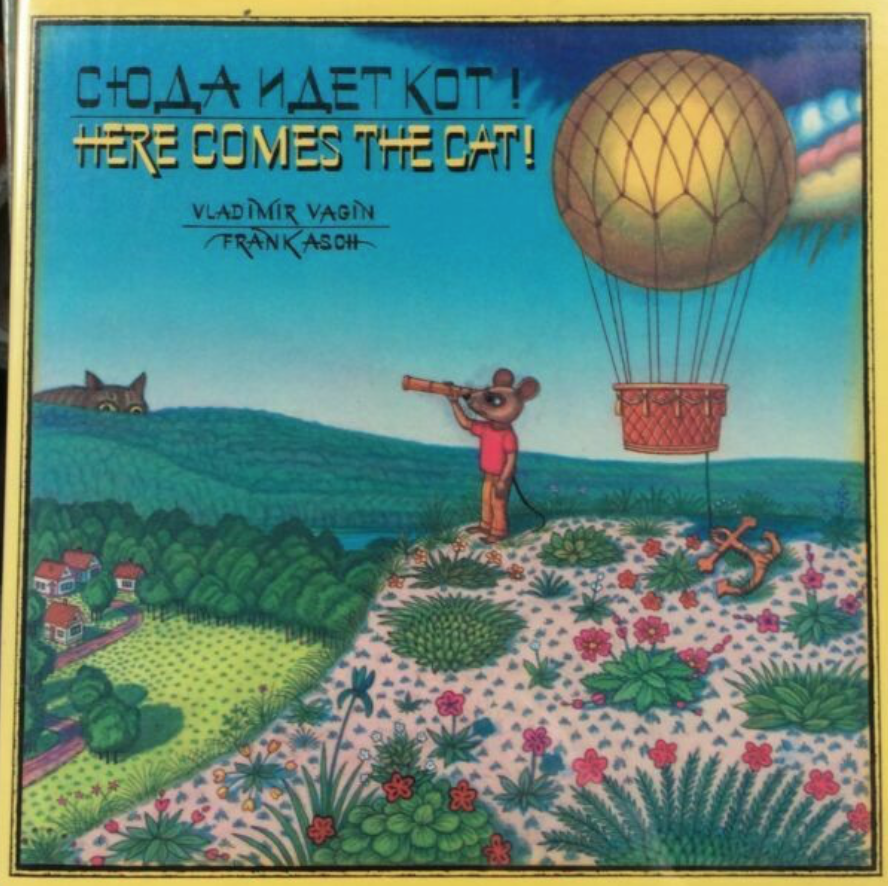Here Comes the Cat!
Book Module Navigation
Summary
Here Comes the Cat! examines questions about friendship, trust, and prejudice.
In a peaceful mouse village, the lookout mouse is alarmed to see the approaching shadow of a large cat. He races through the town, alerting every resident. The cat, however, has harmless intentions. A gift of cheese to the mice helps a friendship develop between two very different kinds of creatures.
Guidelines for Philosophical Discussion
In Here Comes the Cat!, one determined mouse takes a hot air balloon to travel over a countryside, over a beach, under a sea, and through a city. His words are few but his actions are courageous and kind. The philosophical topics for discussion cover morality or ethics, love, friendship, kindness, aesthetics (art), and social and political issues like prejudice. For example, the big fish helps the mouse after he falls from the hot air balloon. This idea relates to what it means to have a friend–to be a kind and caring person in a community. The mice work together so that everyone in the village is fed. Do they do this out of love for one another, out of necessity, or out of commitment?
The creative pictures depict an environment that is aesthetically appealing with lady bugs, butterflies, and ducks that greet one another. By noticing the details of the artwork, children will become stronger observers.
The children will be introduced to social and political issues like assumptions that may lead to prejudice. The questions will have the children ponder what is going on in the different scenes. Are the mice afraid, excited, bored, or curious? Are the mice hungry or hard at work? Part of the discussion will look at personal assumptions and prejudices we have of others and what is behind these feelings which cause us to stereotype. What is expected of a cat or a mouse? Does there always have to be a violent reaction to conflict?
Through discussion, the children will gain a deeper understanding of friendship, assumptions, and prejudices. They will begin to see how trust in themselves and others, participating in acts of giving and receiving instead of attacking, can have significant benefits for all parties involved. The children might notice that an interaction based upon love and peace instead of fear and distrust is transformative and healthier. The cat walking into the mouse community carrying cheese is a powerful statement that peace in everyday interactions is possible.
Questions for Philosophical Discussion
In this story, the cat and the mice are friends.
- What is friendship?
- Can you give me an example of a time when a friend helped you?
- Why do you think it is important for friends to help one another?
- How do you help others?
- Who do you help?
- Why is it good to be able to work with others?
The first picture shows a mouse in a hot air balloon calling down to an artistic mouse painting a picture.
- What is your impression of the picture painted by the mouse?
- Who likes the painting? Who does not? Why or why not?
- Why is discussing art (aesthetics) an important component of philosophy?
The mouse in the hot air balloon calls out to a mouse on a bike.
- How does the mouse on the bike react when he hears the words, “Here comes the cat!”?
- What would you think if you were a mouse and heard “Here comes the cat!”?
- What do you assume the mouse is feeling?
- What role do feelings play in philosophy?
The mouse in the hot air balloon calls “Here comes the cat!” to the mice on the beach.
- Do the mice look threatened by hearing news of an approaching cat?
- Do you think the mouse in the hot air balloon notices the approaching thunder storm?
- Can you predict what will happen?
The clouds become darker. The lightning becomes stronger. The mouse is determined to continue. A bolt of lightning goes through the hot air balloon. The mouse is not discouraged. The mouse is under water with coral, fish, shells, and jelly fish. He meets a fish.The fish helps the mouse by carrying the mouse on its back.
- Was the fish kind to help the mouse?
- Do you have to love someone to be kind to them?
- Are kind acts always selfless?
- If you do a kind act with the knowledge that you will receive something in return, is it still kind?
- Are there times when your friends are not kind?
The mouse enters a village of mice. He calls out, “Here comes the cat!”
- What observations can you make about the mice?
- How does this mouse look when he sees the approaching cat?
- How does the cat look? Threatening? Kind? Content? Proud?
The cat enters the mouse city pulling a big piece of cheese for the mice to share. The collar and leash are taken off of the cat. The mice eat the cheese and the cat gets a back rub and milk.
- Does everyone benefit?
- Do the mice care for the cat?
- Does the cat care for the mice?
- Can you do kind acts without caring?
The mice trust the cat.
- Why is it important to have trust?
- What are the characteristics of trust?
Original questions and guidelines for philosophical discussion by Hannah Esrick. Edited June 2020 by The Janet Prindle Institute for Ethics.
Find tips for leading a philosophical discussion on our Resources page.






